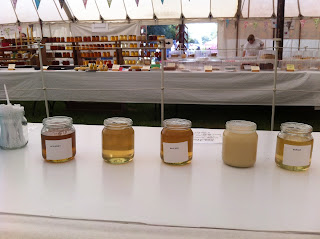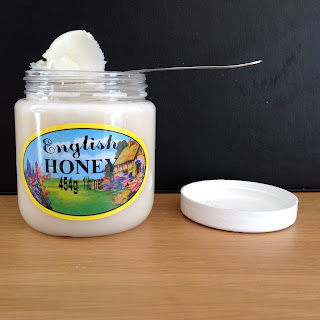The traditional end of the beekeeping season
Last year I had to miss the County Honey Show but I volunteered to help at this year's show. Since I was going to be there anyway, I thought I would get in to the spirit of things and put some entries in the show too.
Scanning the show catalogue, I realised that this would be more challenging than I had envisaged. I wasn't confident about showing our honey, even in the novices classes and I have no idea how to prepare wax for showing. I wasn't inspired to make mead (I prefer sloe gin!) thus it quickly became apparent that I would have to choose to enter one of the baking classes. The show organisers provide a recipe which you have to follow exactly - no room for creative twists here. I have watched The Great British Bake Off so I realised that I would have to practice to avoid embarrassment.
The baking classes consisted of biscuits, fruit cake, honey sponge and apricot and honey scones.
There's only so much fruit cake you can eat and I know biscuits are hard to get right. I feared a soggy bottom, over-baking or underbaking so I started with the promising sounding apricot and honey scones. Scones have never been my strong point and P dismissed them as tasteless and a waste of good honey. Switching to the honey sponge, I found something that everyone liked and was prepared to eat often in the name of testing, even at my first attempt. The recipe was deceptively simple - essentially a Victoria Sponge cake with a little honey to flavour the sponge and sandwiched with honey-flavoured butter cream. The tricky bit was that the recipe didn't specify how long to bake the sponge although it did provide the cooking temperature. In order to prepare properly for the show I had to buy new sandwich tins in the size specified. Too small or too large and my cake would have been rejected.
Weeks before the show I started to practise. I tried making the cake exactly following the recipe and I tried throwing everything into a food mixer. There was no appreciable difference as far as I could see. I took one of the final attempts to the office where the cake was declared delicious but it was already apparent that my problem was uneven baking. I could see exactly why the instructions said not to decorate the top of the cake - evenness of the bake was exactly one of the criteria the judges would be using. I made 2 cakes and selected one for the show, deciding almost immediately that I had chosen he wrong one, but it was too late - P had already eaten most of the other one.
As soon as I entered the honey show marquee and saw the other entries to the baking classes, I knew I was in the presence of greatness. How do you distinguish a plain sponge cake when you aren't permitted to decorate the top even with icing sugar? It's so easy when you know how.....a couple of the honey sponge cakes had been turned onto squared racks to cool leaving the chequered indentations perfectly centred on the top of the cake. Respect!
As I have mentioned before, the most important aspect of any beekeeping event is the refreshments and the County Honey Show was the icing on the cake - so to speak. Immediately after we volunteers were given our rotas and instructions for the day, we were invited to have coffee and tea plate-sized home made biscuits before the first visitors arrived. I was allocated to health & safety on the live beekeeping demonstrations, honey tasting - (no not me - the visitors), answering questions about beekeeping equipment and the central display as well as an hour off for looking around myself. The beekeeping marquee also included beeswax foundation candle making for children, two observation hives, flower arrangements, gardens to attract bees and honey and hive products sales tables.
Lunch was characteristically in two sittings to allow us to sit down to enjoy it properly. A long table had been set up in an ante marquee and lunch consisted of beautiful home made quiches and salads, huge home made meringues with stewed berries and honey to drizzle over the top, all washed down with a choice of sweet or dry mead (and lots of water).
My last shift in the afternoon was on the central display. This was where all the entries for the competitions were displayed. As volunteers our primary job was to to prevent the competition entries from being stolen! During my shift I was sought out by the carriers and instructed to abandon my post for afternoon tea - tea, and a choice of fantastic cakes (not honey flavoured).
And, how did my honey sponge do? You can see in the photograph that the comment says "Baking a little uneven and quite a few air holes. Flavour good." It's an accurate assessment and I wasn't nearly as embarrassed as I would have been if the comment had been "over cooked", "under-baked" or "dry". I learnt a lot. Better still, nephew H won first prize in the children's poster competition - with £6.00 so well done him!


























